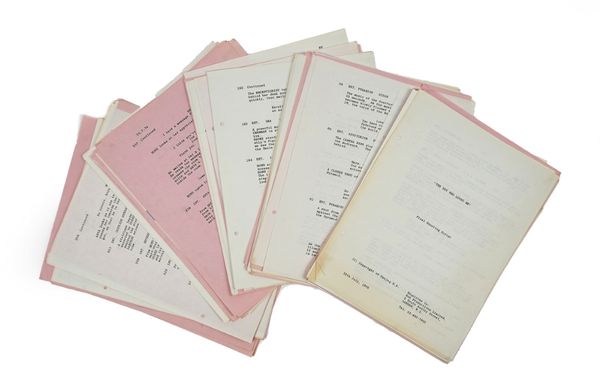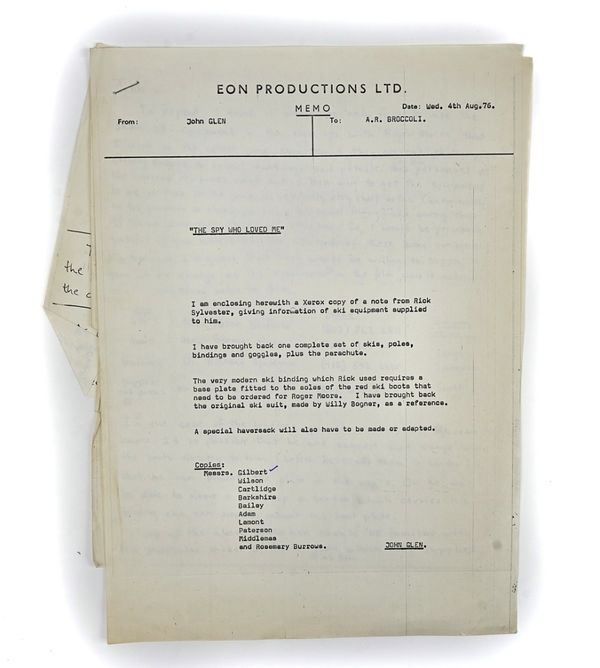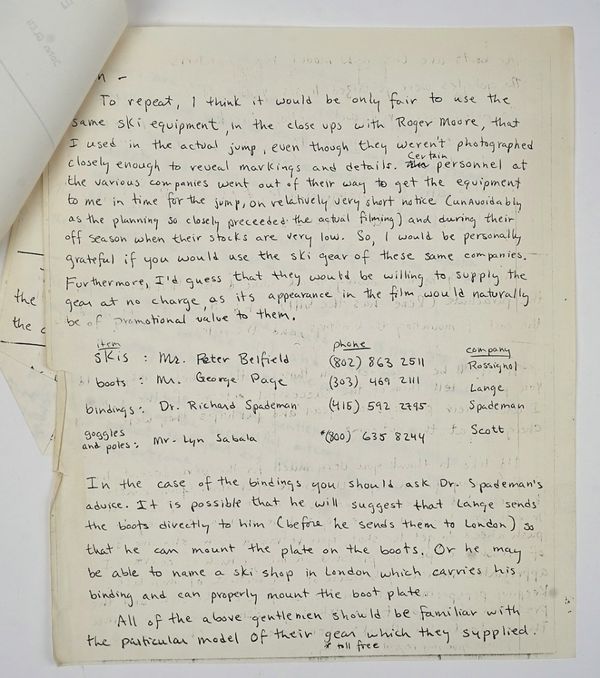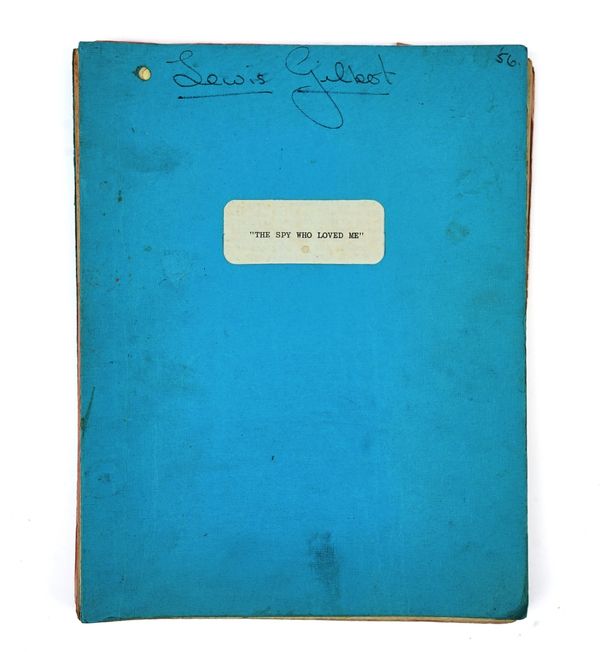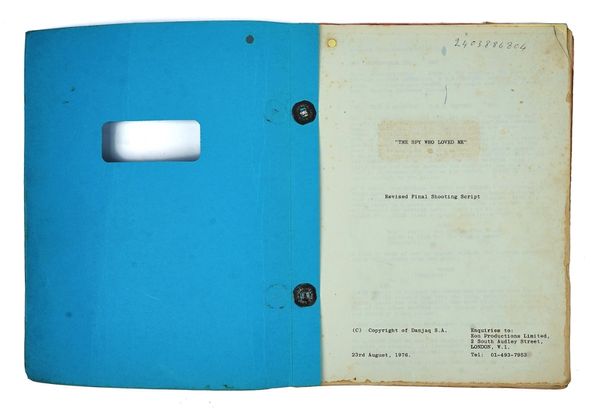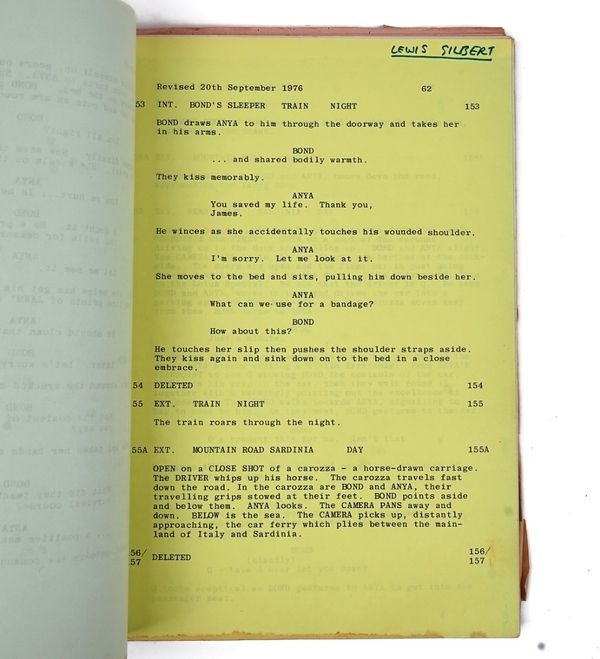JAMES BOND ‘THE SPY WHO LOVED ME’, 1977 – TWO DIRECTOR’S SHOOTING SCRIPTS AND PRODUCTION PAPERWORK REGARDING THE OPENING SKI PARACHUTE JUMP STUNT (3)
| Estimate: | £3,000 - £5,000 |
| Hammer price: | £6,500 |
Lewis Gilbert’s mimeographed typescript shooting script entitled The Spy Who Loved Me, Revised Final Shooting Script with copyright details Copyright of Danjaq S.A., dated 23 August,1976, the title page inscribed at the top in ballpoint pen with a sequence of 10 numbers 2403886804, 133 pp. a few pages annotated in pencil, black and blue ballpoint pen in an unidentified hand; this script including 60 yellow and pink coloured pages of later script revisions dating between 14 September – 6 December 1976, one yellow page dated 20th September 1976 depicting an intimate scene between Bond and Anya on the sleeper train, inscribed at the top in green ink Lewis Gilbert in an unidentified hand, in bright blue card covers, the front cover inscribed Lewis Gilbert in black felt pen in an unidentified hand and numbered 56 at the top right; and
-Another mimeographed typescript shooting script entitled The Spy Who Loved Me, Final Shooting Script with copyright details Copyright of Danjaq S.A, dated 12 July 1976, 142 unbound pp. including 56 coloured pages of script revisions dated 30.7.76; and
- Lewis Gilbert’s xeroxed copy of a mimeographed typescript Memo on Eon Productions Ltd headed stationery, from John Glen to Cubby Broccoli, dated Wed. 4th Aug.76 telling him that he’s enclosing a xerox of a letter from Rick Sylvester [stunt skier for the famous opening ski jump parachute sequence] giving details of ski equipment used, and telling Broccoli that he’d brought back: “ one complete set of skis, poles, bindings and goggles, plus the parachute…and the original ski suit…as a reference” adding that the same red ski boots with their sophisticated binding will need to be ordered for Roger Moore” and “a special haversack will have to be made or adapted.”;
- The Memo stapled to the enclosed 2pp. xeroxed letter from Rick Sylvester which states: “…I think it would be only fair to use the same ski equipment, in the close ups with Roger Moore, that I used in the actual jump, even though they weren’t photographed closely enough to reveal the markings and details. Certain personnel at the various companies went out of their way to get the equipment to me in time for the jump, on relatively very short notice (unavoidably as the planning so closely preceded the actual filming) and during their off season when their stocks are very low…I’d guess they would be willing to supply the gear at no charge, as its appearance in the film would naturally be of promotional value to them…”
- A call sheet dated 6 August 1976; and a handwritten list of timings and actor’s names in black ink in an unidentified hand including; “Felicity York – Arab Girl”
In his autobiography All My Flashbacks, Gilbert recalled how it was Michael Wilson’s idea to use a dramatic ski jump sequence in the film. He’d seen an ad in Playboy magazine which had a photo of a young man skiing off the edge of a mountain over water. They tracked the skier, Rick Sylvester, down in Canada and invited him to England to discuss this stunt. On arrival Sylvester informed them that the photo they’d seen was a fake, he’d been photoshopped in over the sea, however he said he could do it for real and knew exactly the right mountain for it. The precipice Bond was to go over, had to be dead vertical. The spot Sylvester chose for the stunt was Asgard Peak on Baffin Island in the Canadian Arctic. The ski chase that lead up to the jump was shot elsewhere in Switzerland. When it was time to leave for Canada in July 1976, it was second unit director John Glen who set off with Rick. They had to wait five weeks for the optimum conditions for this immensely dangerous stunt. Even with perfect conditions Sylvester had to reach the right speed in order to project himself clear of the precipice. He did and down he fell until, at the last moment, he pulled the cord to a parachute concealed on his back, which when opened revealed a Union Jack (Christopher Wood’s clever detail). Despite the parachute opening successfully, Rick was still in immense danger, as Gilbert recounts: “As soon as the parachute opened, Rick had to jettison his skis. What he didn’t bargain for was the skis shooting straight upwards. They missed the parachute by a matter of inches. If they had become entangled…that would have meant an end to Rick, who was only 24..”. Although Rick was contracted to do two jumps, everything that was needed was captured in the first take, and one of the most memorable openings to any Bond film was in the can.
It’s interesting to note that in both these final versions of the script, the arch-villain’s name has been changed from Stavros. In the Final Shooting Script dated 12 July 1976 it is Markos Landros, a SPECTRE character in previous script versions, who was their chief drug trafficker in north Africa. And in the Revised Final shooting script dated 27 August 1976 it has become Karl Stromberg, the name that was used in the film. Also, in both scripts all references to SPECTRE have also been removed. These amendments were made on the instruction of Cubby Broccoli in order to avoid threatened legal action from Kevin McClory who owned the film rights to Thunderball and was planning a new Bond adaptation of it. Broccoli had insisted that the name Stavros was changed due to its similarity to Ernst Stavro Blofeld’s middle name, and that all references to SPECTRE were taken out. These two elements had been introduced into the Bond universe with Thunderball and by removing them, Cubby hoped to dodge the pending legal issues.
Footnote:
The Spy Who Loved Me (1977), the tenth in the Eon Productions official 007 series, initiated a number of records for the James Bond franchise. It was Cubby Broccoli’s first solo 007 venture without co-producer Harry Saltzman, and he was determined that it should become the biggest and best Bond yet. From the outset, the film’s path to success was beset with numerous difficulties and the screenplay itself went through more adaptations and revisions than any production during the 40-year history of 007 on screen. Problems began with Ian Fleming’s source material for the film’s title. Like the movie, it was Fleming’s tenth Bond novel in order, however it represented a departure from Fleming’s usual 007 format in that it is told from the viewpoint of a young Englishwoman who only meets the famous spy in the last few chapters of the book. For this reason, Fleming never wanted this book to be sold as a film project. His estate, however, gave Broccoli permission to use the novel’s title only. The book and film do also share one significant common element – Jaws, who is loosely based on Fleming’s villain, `Horror’, who had steel-capped teeth. Nevertheless, the screenplay for The Spy Who Loved Me is considered to be the first Bond film whose story is completely original. After a visit to Russia, Broccoli devised a plot for a new story which suited the film’s title and focused on a beautiful Russian agent who falls in love with James Bond.
It is said that twelve different screenwriters worked on fifteen separate drafts for the screenplay over a period of three years, in one of the most fiendishly complicated film pre-production processes in Eon’s history. Considering the quantity of different variants of the screenplay here in Lewis Gilbert’s personal film script archive, it appears that just over half of the fifteen screenplay versions are represented between lots 13-18.
Looking through the different variations of treatments and screenplays for The Spy Who Loved Me, a large proportion of which are represented in this collection, in the words of film historian Steven Jay Rubin they : “…offer a textbook look at script development…the material is priceless, since it allows the reader to see how typical Bondian situations are workshopped…”
Literature:
RUBIN, Steven Jay Spy Who Loved Me Script Wars in The James Bond Movie Encyclopaedia, Chicago Review Press Incorp. Chicago, 2021
GILBERT, Lewis All My Flashbacks The Autobiography of Lewis Gilbert, Sixty Years A Film Director, Reynolds & Hearn, London, 2010
FIELD, Matthew & CHOWDHURY, Ajay Some Kind Of Hero, The Remarkable Story of The James Bond Films, Cheltenham Glouc., 2015
The Spy Who Loved Me Script History www.M16-HQ.com
www.IMDB.com
Bellmans is grateful to Wallace and Hodgson for their assistance with cataloguing the Lewis Gilbert Film Script and Production Archive.
